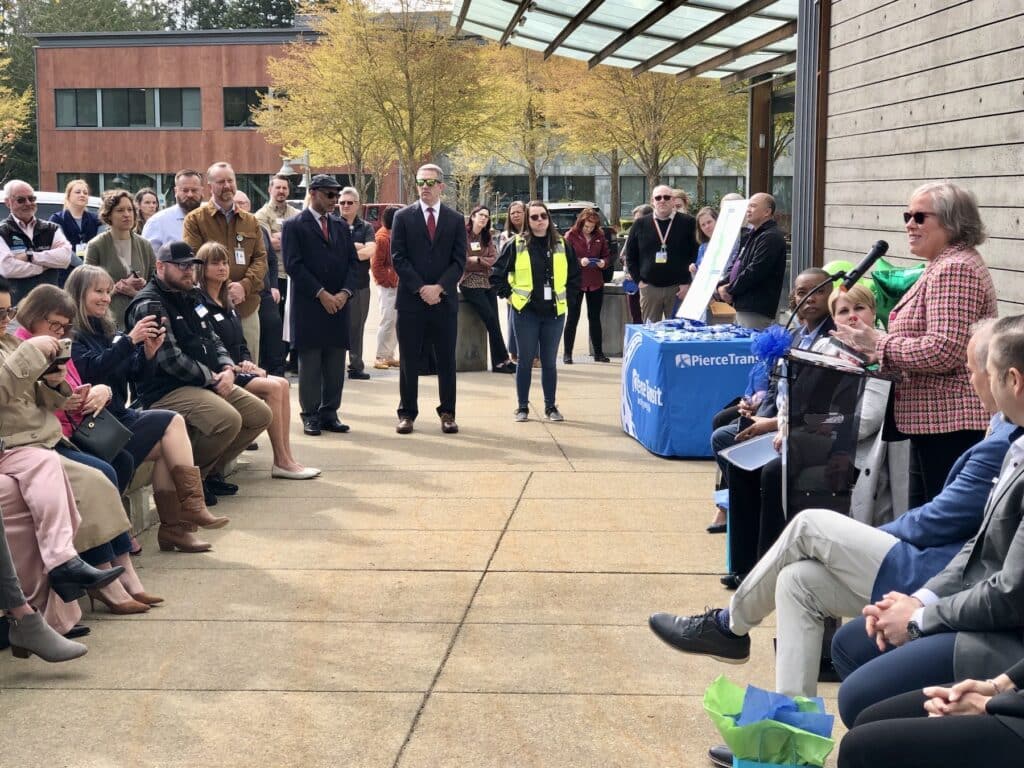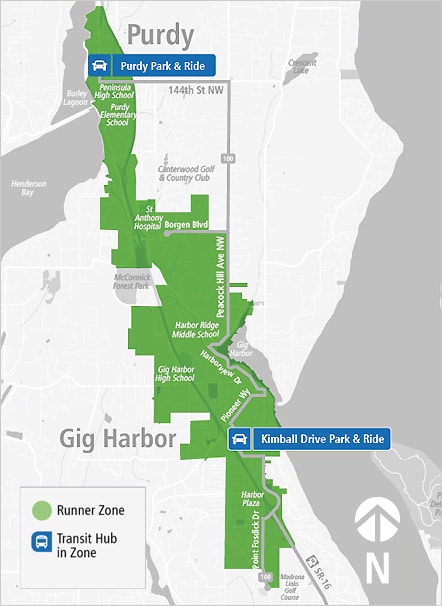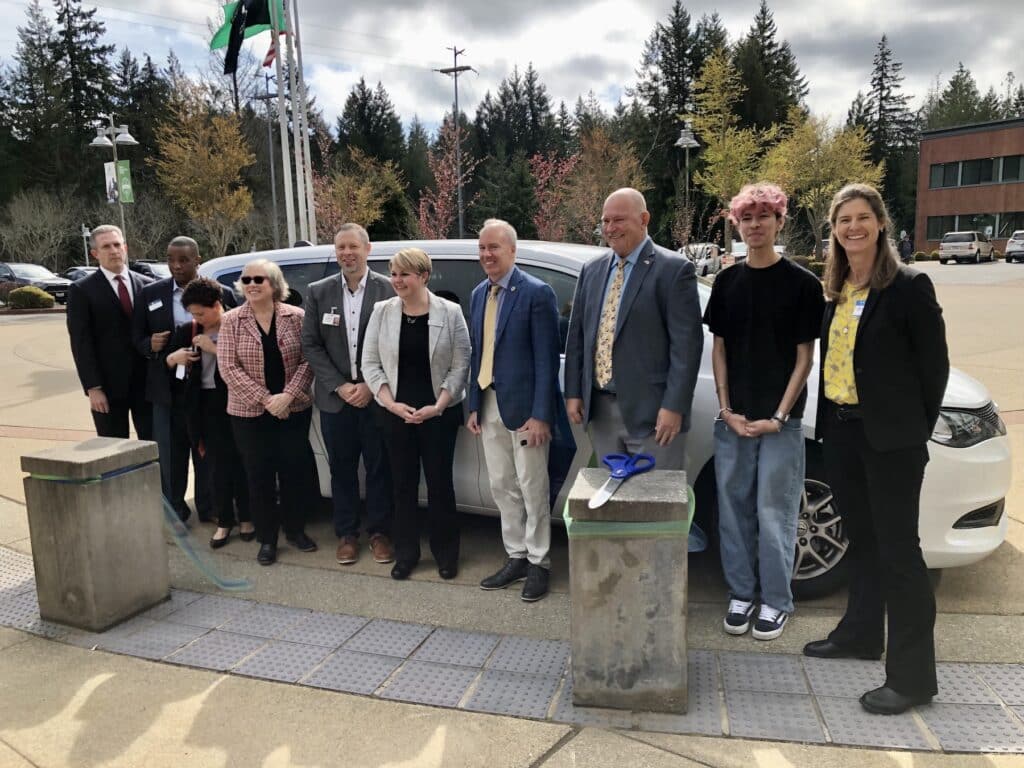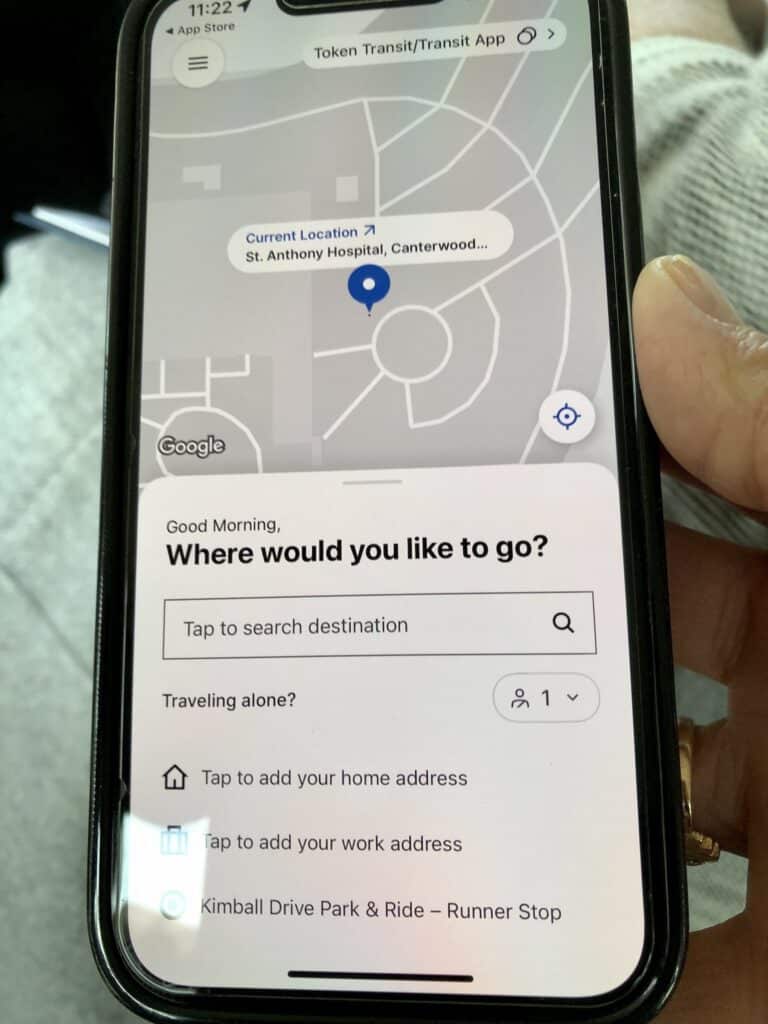Community Government Transportation
Pierce Transit debuts door-to-door, on-demand van service
Be among the first to ride the Gig Harbor Runner.
Pierce Transit launched the new on-demand vans as part of its biannual service changes on Sunday, March 31. The agency held a ribbon-cutting ceremony Monday at St. Anthony Hospital. The transit board had approved door-to-door rides within the city on Dec. 12.
Transit board vice chair and Lakewood mayor Jason Whalen, during the kickoff event outside the hospital, reeled off communities already being served by Runner — Puyallup, Ruston, the Tacoma tideflats, Spanaway and Joint Base Lewis-McChord. He then greeted the sixth and final.

Chamber of Commerce President and CEO Miriam Battson speaks during a ribbon-cutting ceremony at St. Anthony Hospital. Photo by Ed Friedrich
“Welcome, Gig Harbor,” he said to about 40 mostly transit, hospital, city and Tacoma Community College personnel gathered outside of St. Anthony’s.
Runner is the result of a federal research grant to find and test transit service in areas difficult to serve with buses, Whalen said. Pierce Transit was one of 11 agencies to receive funds.
Sixth and final Runner zone
“The fact that they chose us as the sixth and final location, I’m just so honored,” said Gig Harbor Mayor Tracie Markley. “I just hope people use it and use it a lot. I will be using it for sure.”
Markley has received many inquiries from people, particularly those facing mobility challenges, who are frustrated at their inability to attend Summer Sounds or the farmer’s market at Skansie Park. There’s limited parking, and only one disabled space nearby. She, herself, has long suffered from complex regional pain syndrome that at times required her to use a wheelchair or cane.
“We are so excited,” she said. “It’s been years of advocacy. Pierce Transit has been trying for years to come up with a solution.”
The hospital and Tacoma Community College-Gig Harbor made several requests for service. They initially explored branching out Route 100, which runs hourly between the Purdy park-and-ride lot and the Tacoma Community College transfer center. It hits Uptown and Gig Harbor North shopping areas, downtown and the Kimball Drive park-and-ride.
Capital improvement costs and the route’s distance from the college made if financially unfeasible. And there is no safe place to stop at either site.
Hospital had access problem
Hospital Chief Operating Officer Dino Johnson said 18 months ago he was walking through the emergency room and a nurse pulled him aside and said, “We have an access problem here,” he said.
The emergency room treats 100 people a day. Many arrive by ambulance and have no way to get home.
“This is only going to improve access to care,” he said.
Some TCC students ride the bus to the Kimball Drive park-and-ride and walk or ride bikes a mile across the Highway 16 overpass to the college, said Olga Inglebritson, dean of the Gig Harbor campus. Classes have been dropped because of the distance.
“This will allow students to come from the entire community,” she said. “There will no longer be a barrier to education with this new service. It took creative thinking. I thank Pierce Transit for listening to the community.”
Download app or call for ride
Residents can book rides from their phones by downloading a Pierce Transit Runner app or calling (253) 581-8000. Once a person registers, the app will know where they are at any moment. Then they enter where they want to go, Krista Glotzbach of the TransitTech provider Via said during a van ride after Monday’s event.
The screen shows an approximate vehicle arrival time and tracks the van in real time. Texts are sent when the van is two minutes away and when it arrives.
Though Via provides public mobility solutions in 1,000 cities all over the world, microtransit is still an innovative endeavor, Glotzbach said.
Two vans serve Gig Harbor. Riders might be grouped into a single vehicle if rides are going to a similar location, helping to reduce wait times. The driver might receive a request while en route and pick up other people, so users should build in a time cushion. ADA-accessible vans can fit three riders, others can hold up to five.
“It is very much public transit,” Glotzbach said. “It can stop somewhere to pick up another rider.”
Same cost as bus
Rides cost the same as a bus trip — $2 for adults, $1 for seniors and disabled persons, and free for youths 18 and younger. You can’t pay in cash. Pierce Transit accepts Runner fares via an ORCA card, a daily or 30-day pass, or by plugging a credit card number into the transit app on a smartphone.
Runner is limited to the Gig Harbor city limits and with a sliver of land north of the city that encompasses the Purdy park-and-ride lot as Pierce Transit policy is for zones to maintain service only within the agency’s defined service boundaries. The service area was determined years ago through a formal process whereby individuals representing cities throughout Pierce County as well as the county itself determined the agency’s service boundaries, said Pierce Transit spokeswoman Rebecca Japhet.
Connects to buses
Riders can take a Runner van to meet the bus at Purdy or Kimball and make connections for trips outside the area. The vans can also meet up with Route 100 buses anywhere along the way. The Runner is a first- and last-mile connection between one’s starting point and other transit services.
“We’re trying to encourage the use of existing infrastructure by getting people to it,” Glotzbach said.
The service is available from 7 a.m. to 10 p.m. seven days a week except six major holidays.
Grants partially fund some Runner services, but Pierce Transit included the Gig Harbor zone in its 2024 budget. The annual cost is estimated at $355,000. There is no end date.
Rhonda Brown, St. Anthony’s program director, might have best described the new service.
“It’s an Uber ride at transit prices,” she said.



